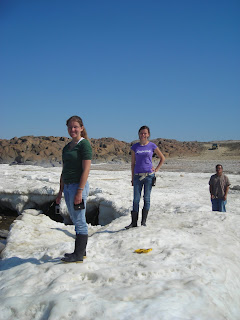 (Map from VIA's website).
(Map from VIA's website). Here I attempt to share one an early morning scene on the tracks, just outside of Capreol, Ontario.
Here I attempt to share one an early morning scene on the tracks, just outside of Capreol, Ontario.Guelph is about 1957 km from Churchill...but of course that distance is if you could travel in a straight line. The actual distance travelled by train takes in a few more turns.While some of these km may seem desolate, the history of the train line is far from sparse. At rest stops along the way I was able to learn a little more about the railway. For instance, I learned that starting in the early 1900s, most railway stations had elaborate railway gardens, set up as showpieces that would be the first thing passengers would see as they entered a new community. The point of this was to encourage passengers in rural parts of Canada. I enjoyed the train and really do feel that it is a method of transportation worth supporting.
Since arriving in Churchill, I have delved into another research season as a planktoneer...
(Photo: taken by Krista Hanis)
and have been slowly been regaining my bluff legs. As a recap, my project focuses on freshwater zooplankton communities along the coast of Hudson Bay and how they respond to changes in environment, most notably, the saltiness or salinity of the water. This year I am really interested in how the resting stages of zooplankton ( for example, this Daphnia ephippia below- I also like describe them as dumplings) may impact zooplankton's ability to recover from disturbance and stress.
 The pouch like things pictured above are essentially dormant eggs released by mature Daphnia. And this is how our spotlight on travel fits in...Last year I spent a lot of time thinking about how zooplankton might "commute" around the rock bluffs without thinking much about the idea that sometimes it is easier to stay put and just wait out unfavourable environmental conditions- more on this later.
The pouch like things pictured above are essentially dormant eggs released by mature Daphnia. And this is how our spotlight on travel fits in...Last year I spent a lot of time thinking about how zooplankton might "commute" around the rock bluffs without thinking much about the idea that sometimes it is easier to stay put and just wait out unfavourable environmental conditions- more on this later.
Well my arrival back at the CNSC has been filled with science, catching up with friends from last year and enjoying some very hot spring weather. I'm looking forward to the rest of the summer and many more planktoneer adventures in this place where there is always more to learn.
Below are some pictures of some coastal exploration with some of the other researchers from Guelph: Liz, Emily and Jinjing.



 This is a specially crafted snowball...it has pieces of ice for extra protection...
This is a specially crafted snowball...it has pieces of ice for extra protection...
No comments:
Post a Comment